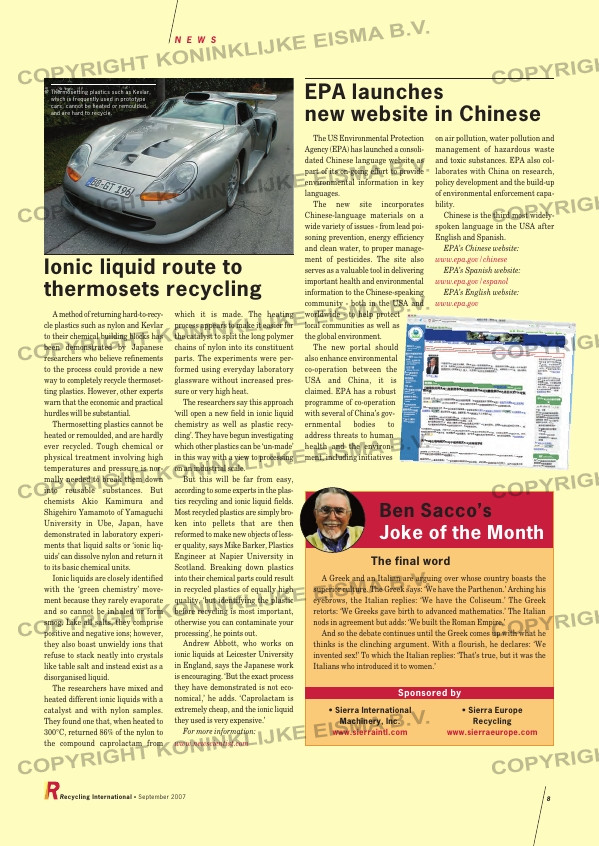Page 8 from: September 2007

A method of returning hard-to-recy-
cle plastics such as nylon and Kevlar
to their chemical building blocks has
been demonstrated by Japanese
researchers who believe refinements
to the process could provide a new
way to completely recycle thermoset-
ting plastics. However, other experts
warn that the economic and practical
hurdles will be substantial.
Thermosetting plastics cannot be
heated or remoulded, and are hardly
ever recycled. Tough chemical or
physical treatment involving high
temperatures and pressure is nor-
mally needed to break them down
into reusable substances. But
chemists Akio Kamimura and
Shigehiro Yamamoto of Yamaguchi
University in Ube, Japan, have
demonstrated in laboratory experi-
ments that liquid salts or ‘ionic liq-
uids’ can dissolve nylon and return it
to its basic chemical units.
Ionic liquids are closely identified
with the ‘green chemistry’ move-
ment because they rarely evaporate
and so cannot be inhaled or form
smog. Like all salts, they comprise
positive and negative ions; however,
they also boast unwieldy ions that
refuse to stack neatly into crystals
like table salt and instead exist as a
disorganised liquid.
The researchers have mixed and
heated different ionic liquids with a
catalyst and with nylon samples.
They found one that, when heated to
300°C, returned 86% of the nylon to
the compound caprolactam from
which it is made. The heating
process appears to make it easier for
the catalyst to split the long polymer
chains of nylon into its constituent
parts. The experiments were per-
formed using everyday laboratory
glassware without increased pres-
sure or very high heat.
The researchers say this approach
‘will open a new field in ionic liquid
chemistry as well as plastic recy-
cling’. They have begun investigating
which other plastics can be ‘un-made’
in this way with a view to processing
on an industrial scale.
But this will be far from easy,
according to some experts in the plas-
tics recycling and ionic liquid fields.
Most recycled plastics are simply bro-
ken into pellets that are then
reformed to make new objects of less-
er quality, says Mike Barker, Plastics
Engineer at Napier University in
Scotland. Breaking down plastics
into their chemical parts could result
in recycled plastics of equally high
quality, ‘but identifying the plastic
before recycling is most important,
otherwise you can contaminate your
processing’, he points out.
Andrew Abbott, who works on
ionic liquids at Leicester University
in England, says the Japanese work
is encouraging. ‘But the exact process
they have demonstrated is not eco-
nomical,’ he adds. ‘Caprolactam is
extremely cheap, and the ionic liquid
they used is very expensive.’
For more information:
www.newscientist.com
N E W S
Recycling International • September 2007 8
The final word
A Greek and an Italian are arguing over whose country boasts the
superior culture. The Greek says: ‘We have the Parthenon.’ Arching his
eyebrows, the Italian replies: ‘We have the Coliseum.’ The Greek
retorts: ‘We Greeks gave birth to advanced mathematics.’ The Italian
nods in agreement but adds: ‘We built the Roman Empire.’
And so the debate continues until the Greek comes up with what he
thinks is the clinching argument. With a flourish, he declares: ‘We
invented sex!’ To which the Italian replies: ‘That’s true, but it was the
Italians who introduced it to women.’
Ben Sacco’s
Joke of the Month
Sponsored by
• Sierra International
Machinery, Inc.
www.sierraintl.com
• Sierra Europe
Recycling
www.sierraeurope.com
Thermosetting plastics such as Kevlar,
which is frequently used in prototype
cars, cannot be heated or remoulded,
and are hard to recycle.
Ionic liquid route to
thermosets recycling
EPA launches
new website in Chinese
The US Environmental Protection
Agency (EPA) has launched a consoli-
dated Chinese language website as
part of its on-going effort to provide
environmental information in key
languages.
The new site incorporates
Chinese-language materials on a
wide variety of issues – from lead poi-
soning prevention, energy efficiency
and clean water, to proper manage-
ment of pesticides. The site also
serves as a valuable tool in delivering
important health and environmental
information to the Chinese-speaking
community – both in the USA and
worldwide – to help protect
local communities as well as
the global environment.
The new portal should
also enhance environmental
co-operation between the
USA and China, it is
claimed. EPA has a robust
programme of co-operation
with several of China’s gov-
ernmental bodies to
address threats to human
health and the environ-
ment, including initiatives
on air pollution, water pollution and
management of hazardous waste
and toxic substances. EPA also col-
laborates with China on research,
policy development and the build-up
of environmental enforcement capa-
bility.
Chinese is the third most widely-
spoken language in the USA after
English and Spanish.
EPA’s Chinese website:
www.epa.gov/chinese
EPA’s Spanish website:
www.epa.gov/espanol
EPA’s English website:
www.epa.gov
RI_006 NEWS:Opmaak 1 05-09-2007 12:18 Pagina 8



